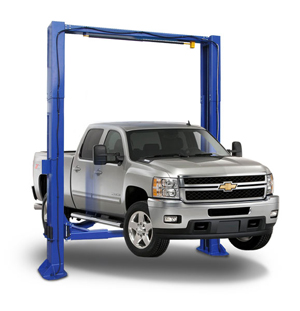Car Lift Buying GuideMany people look to local mechanics when issues pop up with their vehicles. Working on these vehicles involves having the right space to do so, which is where powerful car lifts come in. They let you hoist vehicles up, allowing you easier access for more efficient and comfortable work. Making sure you have all the equipment necessary to service any car that drives up to your shop is essential, but it can be difficult to get the best fit for your requirements. Read through our car lift buying guide and get the information you need to find the best fit for your space. 
Car Lift ChoicesThe biggest choice you will want to make when narrowing down your options is between two and four post lifts. These two main types of car lifts have a few primary differences, and they will have different effects on your shop and the work you wish to perform. Two post lifts work by hoisting a car up from the middle, while four post lifts raise the vehicle up from around the wheels. This causes a few big differences that you will want to keep in mind when deciding on the perfect lift for you. Two Post LiftsFirst, two post lifts support the vehicle from its midsection, with the vehicle’s frame resting on the supports. This means that two post lifts save a bit of space when raising vehicles. The wheels of the vehicle will fall below the supporting arms. This can save up to 17 inches and more in total height, depending on the vehicle, helping shops with low ceilings fit their lifted vehicle more easily. Most two post lifts raise vehicles around six feet in height, and the saved height can be the difference between fitting your lift and vehicle in a standard one-story building or not. Four Post LiftsFour post lifts do not save any space in total effective height. However, they have a more open design that allows easier access to the vehicle. Because two post lifts support the vehicle from the center, it can be difficult to access every part of the car for maintenance and repairs. Four post lifts offer easy access to the underside of the vehicle, though they restrict access to the wheels. Auxiliary lifts can combine with four post lifts to raise the vehicle off the runways and allow wheel access. Comparing two and four post liftsAnother primary difference between two and four post lifts is the amount of space they require. The length of a two post lift is essentially the length of the vehicle being lifted, while four post lifts require extra length to support the vehicle. Four post lifts can be as long as 26 feet, with heavy duty machines as long as 36 feet. This can consume a lot of space in your shop, so make sure you are prepared if you intend to choose a four post lift. Weight capacity is another factor to consider. Four post lifts are generally capable of lifting a lot more weight, and standard models range from 7,000 to 14,000 pounds and more, with heavy duty lifts coming in up to 40,000 pounds. Most two post lifts range from 7,000-10,000 pounds, giving them a more limited range of vehicles they can work on. If you regularly service large vehicles, especially commercial or industrial vehicles, you will want to make sure you have enough power for the job. Smaller shops can often see a lot of benefit from choosing a two post lift. They are extremely useful machines and very effective in getting the job done. Best of all, they are less expensive than their four post counterparts. Two post lifts can range as low as $1000-2000, being a great option for family owned shops and local mechanics. Larger shops that need more lifting power might consider investing in four post lifts. While they can be much more expensive, they can also provide more functionality that will help service many different types of vehicles. Need more help? Ask our car lift experts to help you pick out the best solution for your shop today! Call us at: 855.275.5141 Related Topics |
Homepage


Installation & Delivery, Service, Parts, Will Call
Locations Across The Nation
TO SERVE
THE ENTIRE
COUNTRY








 Owned & Operated in the U.S. since 1987
Owned & Operated in the U.S. since 1987




